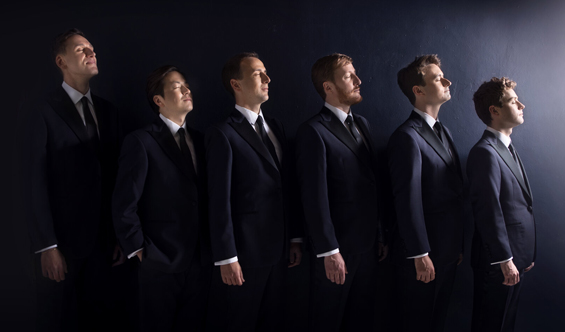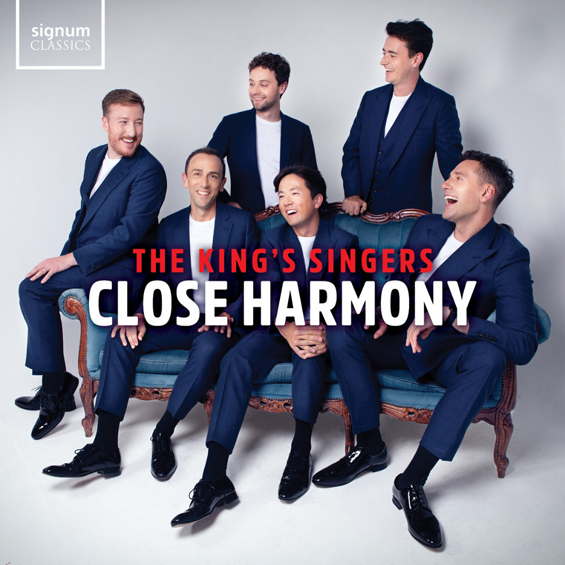

(l-r)
Nick Ashby,
Edward Button,
Jonathan Howard,
Christopher Bruerton,
Julian Gregory,
Patrick Dunachie
(photo: Frances Marshall)
FIVE QUESTIONS WITH THE KING'S SINGERS
The King's Singers formed when six choral scholars from King's College, Cambridge delivered a 1968 concert at London's Queen Elizabeth Hall. Fifty-six years on from that auspicious event, the group's current members, countertenors Patrick Dunachie and Edward Button, tenor Julian Gregory, baritones Christopher Bruerton and Nick Ashby, and bass Jonathan Howard, uphold the “gold standard” their a cappella forefathers set so long ago. Personnel changes have occurred, naturally, throughout the group's tenure and will no doubt continue into the future, but whenever a new singer joins the others are there to ease the transition and welcome him into the fold.
The King's Singers are known for incredible technique, musicianship, and versatility; with respect to the latter, the members are as comfortable singing classical pieces and chart-topping songs as folk ballads, Broadway tunes, and American songbook classics, and they've also expanded their repertoire with more than 200 commissioned works by composers such as John Tavener, Joe Hisaishi, Eric Whitacre, and György Ligeti. This month finds the group adding to its decades-spanning discography with the terrific Close Harmony (reviewed here), an encompassing, double-disc collection that includes selections representing all of those aforesaid genres. textura was thrilled to recently touch base with Patrick Dunachie and Jonathan Howard to discuss the new release, personnel changes, song arrangements, and the group's incredible range.
1. Every album by The King's Singers is different, whether it be the Disney-themed When You Wish Upon a Star or last year's audacious celebration of commissioned works, Wonderland. Could you say a few words about the specific theme behind Close Harmony?
(Jonathan Howard) There's no question in my mind that the close harmony section of our (now bursting) library is the most loved, requested, and unique corner of it. It's been a long time since we recorded an album that celebrates its full breadth: from folk songs in foreign languages to contemporary jazz and pop music. That's the honest, simple reason that we made this record: to treasure some of this line-up's favourite close harmony arrangements from across the group's fifty-six-year history, as well as to honour the wonderful time the six of us have had together as the current six King's Singers.

photo: Frances Marshall
2. With such a vast repertoire to draw upon—the group has commissioned more than 200 works to go with an ever-growing collection of arrangements of non-commissioned material—was it easy or difficult to reach consensus about the set-list for Close Harmony? With six members in the group, do differences of opinion arise about song choices, and if they do (being an even-numbered group) how do you resolve those differences? Relatedly, does the group have an Artistic Director or is it one where each member has an equal say about operational matters?
(Patrick Dunachie) There is no single artistic director, but neither is there an absence of artistic directorship! We all share the responsibility musically and artistically, both on stage (as we breathe to begin every phrase) and in the planning (where we discuss, debate, share, and decide what we'll sing and why). Voting on things with six people can sometimes be tricky, and we'll prolong a decision process if we have to in order to get a good result. But often, there may be one or two guys who are 'persuade-ables' and will follow an emerging majority. But enough politics! Getting to the track listing here actually wasn't too difficult. For a start, we've been building up this track list very gradually over years, as we recorded the material in batches since 2019. But we also had a few helpful parameters for what we wanted it to be: a good quota of stuff from the very early days that hasn't been heard for ages; a similar amount of material which has been written very recently and reflects today's tastes; and in the middle, real audience favourites that haven't been recorded for a fair while (or at all, in the case of Master-Piece!). In trying to get a balance of these three elements, the track list emerged quite swiftly. And we knew early on this would need to be a double album!

3. Many of the songs have complex vocal arrangements, Paul Drayton's (newly updated for 2024) "Master-Piece," of course, but also the ones Andrew Jackman and Daryl Runswick respectively created for “Crocodile Rock” and “Ob-la-di, Ob-la-da.” Using either the Elton John or Beatles song as a representative illustration, how many hours, days, or weeks did it take to master its arrangement, and how do you approach it? Do you learn your parts individually first when tackling a new piece and then come together, or is it a group undertaking from the start?
(Jonathan) You know what? Some of these arrangements aren't as complicated as you might think. I know, for example, that “Ob-la-di, Ob-la-da” sounds insane, but that's because all six parts are doing something quite different. Individually, each line makes harmonic and rhythmic sense and therefore isn't that difficult to learn on its own. The way we work is that people prepare their own parts at home before we come together to rehearse the piece as a group for the first time. We then choose a new section each rehearsal so the whole piece slowly gets under our collective skin. After five or six rehearsals, and now armed with an idea of how to craft the whole performance, we memorize the piece. And it's only when the piece is fully memorized that we can finish choreographing it (iPads and music stands get in the way), and have it audience-ready.

photo: Frances Marshall
4. The King's Singers formed in 1968 and has undergone regular personnel changes over the years. Patrick, you've been a member since 2016 and Jonathan since 2010, and of course you recently announced that you'll be leaving the group at the end of the year, with Piers Connor Kennedy set to step in as the next bass in January 2025. Is it a bittersweet feeling knowing that eventually each member will pass the torch to someone new, and, Jonathan, how does it feel when you're in a kind of in-between state as someone who's still a member yet also preparing to leave? And as both of you have witnessed changes in the group's membership, how great an impact does personnel change have on the group's chemistry when it happens?
(Jonathan) Honestly, I think it's a great relief to know that there's someone great waiting to fill your shoes when you decide it's time to leave the group. For me, the decision to stand down after just over fourteen years was an easy one. I adore this job and always have. But I also knew I never wanted to outstay my welcome, or to feel like I couldn't deliver what the group needed, musically or otherwise. These last few months are a total joy. I'm getting to enjoy all the benefits of extraordinary global touring with people I love while not having to engage too heavily with planning for the future (it's important I leave that to the five singers who are continuing). As for how the group's internal dynamic changes when members come and go, we're like a family, so departures and arrivals are definitely felt. I've found the turnover of characters in the group a vital part of keeping the group's energy up and keeping a freshness in the way we make music on stage.

photo: Frances Marshall
5. In addition to material arranged by Andrew Jackman, Daryl Runswick, Jim Clements, Bob Chilcott, and others, a number of songs were arranged by group members, including Queen's “Good Old-Fashioned Lover Boy” and Christine McVie's “Songbird” by Nick Ashby, Mike Scott's “How Long Will I Love You?” by Christopher Bruerton, and Kacey Musgraves' “Rainbow” and Joni Mitchell's “Sisotowbell Lane” by Patrick. Using “Rainbow” as a case study, could you describe, Patrick, how you go about crafting the arrangement for a song? Do you use the artist's own recorded version as a guide or is your preference not to be influenced by the artist's treatment?
(Patrick) Every one of the arrangers in the group works slightly differently, but in the case of “Rainbow,” it was actually a live performance of the song by Kacey in Los Angeles (the song's premiere, in fact) that got the idea in my head. When I heard the beautiful contour of the melody in the chorus—particularly the lovely rising sixth up to the word “umbrella”—I could instantly hear it in our voices, and I could picture the chord voicings (basically two separate trios) that could make it work. From that point, it was just a constant balance of staying faithful to the artist's song and not messing with it, whilst keeping creative and not becoming a slave to what you're hearing.
Bonus question: The group's versatility is captured tremendously on the album when so many vocal styles appear, from doo-wop, swing, and gospel to soul, folk, and even Cossack dance chanting, and innovative vocal techniques enliven the album too—vocal percussion on Paul Simon's “Fifty Ways to Leave Your Lover” and Albert Hammond's “I'm a Train,” buzzing effects in Rimsky-Korsakov's “Flight of the Bumblebee,” and simulated horns in Duke Ellington's “Creole Love Call.” Fittingly, the album concludes with Ron Goodwin's “What kind of things do The King's Singers sing?,” the answer to which, of course, is pretty much everything. Is there anything, though, that the group hasn't yet tackled and has plans to do in the future?
(Patrick) Great question. The answer we'd often joke with is hip hop—which has rather limited options for a cappella adaptation, let alone thinking about the hideous image of the six of us try to rap. The real answer is actually plainchant. We often use plainchant in live concerts—it can act like a kind of sorbet that helps regulate the flow of a concert programme—but we've not really focused recordings around it. But we always really enjoy singing it, and it suits our sound beautifully. So we're working at the moment on a recording which may have plainchant as a backbone throughout. I'm really excited by the prospect; something different from normal, which has the potential to be stunning!website: THE KING'S SINGERS
October 2024![]()